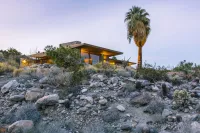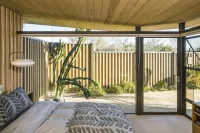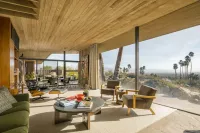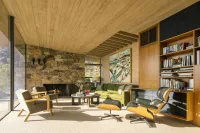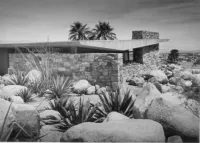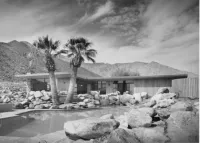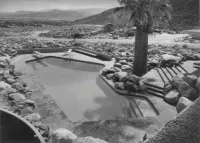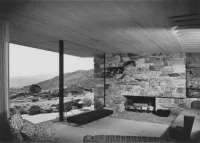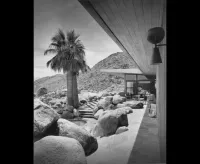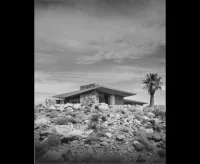Share what you know,
and discover more.
Share what you know,
and discover more.
Jan 05, 2018
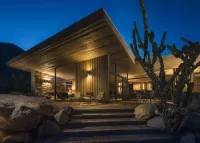
-

- Dave D
Ravishing midcentury home in Palm Springs yours for $3.2M
Designed by prolific SoCal architect E. Stewart Williams, this modernist gem in Palm Springs could be yours for $3.2 million. It was built in 1954 for movie theater and tomato farm owner William Edris and his wife, Marjorie, who gave the architect carte blanche to design a home that looked “as if it grew out of the ground rather than falling out of the sky.” The 2,700-square-foot home emerges from its rocky desert landscape like a natural feature made of stone, wood cladding, and glass. Its combination of horizontal roofline and vertically oriented siding give it a strong midcentury character. Inside, the three-bedroom home boasts a large stone fireplace, wood-paneled ceiling, and gorgeous views from its floor-to-ceiling windows of the valley beyond. Sliding glass walls open up the space to a flagstone patio with a sleek, geometric pool and rocky garden. The home, previously listed for $4.2 million in January 2017, got a big price chop in the fall. It was added to the National Register of Historic Places in 2016.
Ravishing midcentury home in Palm Springs yours for $3.2M
Designed by prolific SoCal architect E. Stewart Williams, this modernist gem in Palm Springs could be yours for $3.2 million. It was built in 1954 for movie theater and tomato farm owner William Edris and his wife, Marjorie, who gave the architect carte blanche to design a home that looked “as if it grew out of the ground rather than falling out of the sky.” The 2,700-square-foot home emerges from its rocky desert landscape like a natural feature made of stone, wood cladding, and glass. Its combination of horizontal roofline and vertically oriented siding give it a strong midcentury character. Inside, the three-bedroom home boasts a large stone fireplace, wood-paneled ceiling, and gorgeous views from its floor-to-ceiling windows of the valley beyond. Sliding glass walls open up the space to a flagstone patio with a sleek, geometric pool and rocky garden. The home, previously listed for $4.2 million in January 2017, got a big price chop in the fall. It was added to the National Register of Historic Places in 2016.
Jan 05, 2018
Ravishing midcentury home in Palm Springs yours for $3.2M
Designed by prolific SoCal architect E. Stewart Williams, this modernist gem in Palm Springs could be yours for $3.2 million. It was built in 1954 for movie theater and tomato farm owner William Edris and his wife, Marjorie, who gave the architect carte blanche to design a home that looked “as if it grew out of the ground rather than falling out of the sky.”The 2,700-square-foot home emerges from its rocky desert landscape like a natural feature made of stone, wood cladding, and glass. Its combination of horizontal roofline and vertically oriented siding give it a strong midcentury character.
Inside, the three-bedroom home boasts a large stone fireplace, wood-paneled ceiling, and gorgeous views from its floor-to-ceiling windows of the valley beyond. Sliding glass walls open up the space to a flagstone patio with a sleek, geometric pool and rocky garden.
The home, previously listed for $4.2 million in January 2017, got a big price chop in the fall. It was added to the National Register of Historic Places in 2016.
Posted Date
Dec 20, 2021
Historical Record Date
Jan 05, 2018
Source Name
Curbed
Delete Story
Are you sure you want to delete this story?
Nov 10, 2016
Nov 10, 2016
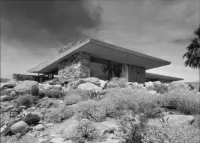
-

- Dave D
National Register of Historic Places - Summary
Summary Paragraph The Edris Residence, designed in 1953 and completed in 1954 for William and Marjorie Edris, was set amidst a boulder-strewn alluvial fan of Mt. San Jacinto in Palm Springs. The goal was to integrate as much of the natural environment into modern design as possible. Although of steel frame construction, the exterior of the modest-sized house was clad in native rock and board-and-batten Douglas fir siding. Williams employed a triangular steel truss so that the living room roof would slope upward to celebrate the magnificent view. The Edris Residence retains an exceptionally high level of integrity, perfectly exhibiting Williams’ philosophy that modern design should express the natural environment in which it is located. Narrative Description The Edris House exhibits many elements that appeared in Williams’ residential commissions throughout his career: a steel structural frame, shed roof, deep overhangs, large expanses of fixed glazing, sliding glass doors, and, most importantly, the integration of natural materials such as wood cladding and native rock into his modern designs. The site in Palm Springs’ Tuscany Hills was chosen specifically for its rugged natural setting. Williams’ goal was to move as few boulders as possible so that the 2,700 square foot, L-shaped house would appear to grow out of the desert landscape. Williams framed the house in steel, utilizing a triangular truss to allow the roof to rise so that panoramic views of the vast Coachella Valley were visible from the elevated site. The steel frame also supported the natural wood cladding used throughout the house. On the exterior, board-and-batten Douglas fir siding covered most surfaces; on the interior, wood paneling was used for walls and ceilings, the latter of which continued past walls of glass or wood to form extended eaves. Native rock veneer on south and west elevations provided a striking contrast to smooth wood and glass surfaces. The natural rock chimney that visually anchors the house to the site extends past the living room’s floor-to-ceiling windows, dissolving the barrier between indoors and outdoors. The interior consists of a large open public area with a bedroom on each end. The open kitchen merges with a seating area that flows into the dining space and living room. An indoor planter features a row of steel rods topped by lights with small Dixie Cup-inspired metal shades. Another indoor planter is to the right of the front door as one enters. The master bedroom occupying the north wing eschews interior barriers such that the bedroom merges with the dressing and bathroom areas, and small office space. The mosaic wall tiles and fixtures of the washroom, lavatory, shower, and bathtub are all original. Enormous plate glass windows fill the area with light. Beautiful wood paneled closet doors run the length of one wall with a built-in combination sink, medicine cabinet, vanity, and dresser centering the room. Throughout the house are Williams-designed built-in cabinets, shelving, storage spaces, and a wet bar hidden behind folding wood doors. Interior and exterior sculptural metal sconces are also customs designed by Williams. The bedroom on the south end of the house differs from the master bedroom in that its west wall is of sturdy native rock topped by clerestory windows. The room’s south wall consists of fixed windows, sliding glass doors, and a pair of built-in dressers. Like the master bedroom, this bathroom features original cabinets, mosaic tiles, and fixtures. Walkways and patio decks feature Arizona flagstone that merge with boulders embedded in concrete. A flagstone path descends from the rear patio to the irregularly shaped swimming pool that Williams nestled into a small arroyo. A gravel driveway leads to an enclosed garage and the sheltered main entrance. The original building permits dated 1953 reveal that the seven-room dwelling cost approximately $50,000 to construct, a large sum for a house at that time. The foundation alone was another $4,500 and the swimming pool cost $6,000. The only other building permit is dated 2003 and is for a spa that was constructed at the rear of the house, shielded by a wood fence. Remarkably, the house has had only two owners and there have been no alterations to its original design. The property retains the essential physical features associated with the residential work of E. Stewart Williams, melding the natural environment with a modern design that was the essence of Williams’ architectural philosophy. The Edris Residence remains the most original, best-preserved example of a Williams-designed residence in Palm Springs retaining all aspects of integrity and fully conveying its architectural significance. All photos © J. Paul Getty Trust. Getty Research Institute, Los Angeles (2004.R.10)
National Register of Historic Places - Summary
Summary Paragraph The Edris Residence, designed in 1953 and completed in 1954 for William and Marjorie Edris, was set amidst a boulder-strewn alluvial fan of Mt. San Jacinto in Palm Springs. The goal was to integrate as much of the natural environment into modern design as possible. Although of steel frame construction, the exterior of the modest-sized house was clad in native rock and board-and-batten Douglas fir siding. Williams employed a triangular steel truss so that the living room roof would slope upward to celebrate the magnificent view. The Edris Residence retains an exceptionally high level of integrity, perfectly exhibiting Williams’ philosophy that modern design should express the natural environment in which it is located. Narrative Description The Edris House exhibits many elements that appeared in Williams’ residential commissions throughout his career: a steel structural frame, shed roof, deep overhangs, large expanses of fixed glazing, sliding glass doors, and, most importantly, the integration of natural materials such as wood cladding and native rock into his modern designs. The site in Palm Springs’ Tuscany Hills was chosen specifically for its rugged natural setting. Williams’ goal was to move as few boulders as possible so that the 2,700 square foot, L-shaped house would appear to grow out of the desert landscape. Williams framed the house in steel, utilizing a triangular truss to allow the roof to rise so that panoramic views of the vast Coachella Valley were visible from the elevated site. The steel frame also supported the natural wood cladding used throughout the house. On the exterior, board-and-batten Douglas fir siding covered most surfaces; on the interior, wood paneling was used for walls and ceilings, the latter of which continued past walls of glass or wood to form extended eaves. Native rock veneer on south and west elevations provided a striking contrast to smooth wood and glass surfaces. The natural rock chimney that visually anchors the house to the site extends past the living room’s floor-to-ceiling windows, dissolving the barrier between indoors and outdoors. The interior consists of a large open public area with a bedroom on each end. The open kitchen merges with a seating area that flows into the dining space and living room. An indoor planter features a row of steel rods topped by lights with small Dixie Cup-inspired metal shades. Another indoor planter is to the right of the front door as one enters. The master bedroom occupying the north wing eschews interior barriers such that the bedroom merges with the dressing and bathroom areas, and small office space. The mosaic wall tiles and fixtures of the washroom, lavatory, shower, and bathtub are all original. Enormous plate glass windows fill the area with light. Beautiful wood paneled closet doors run the length of one wall with a built-in combination sink, medicine cabinet, vanity, and dresser centering the room. Throughout the house are Williams-designed built-in cabinets, shelving, storage spaces, and a wet bar hidden behind folding wood doors. Interior and exterior sculptural metal sconces are also customs designed by Williams. The bedroom on the south end of the house differs from the master bedroom in that its west wall is of sturdy native rock topped by clerestory windows. The room’s south wall consists of fixed windows, sliding glass doors, and a pair of built-in dressers. Like the master bedroom, this bathroom features original cabinets, mosaic tiles, and fixtures. Walkways and patio decks feature Arizona flagstone that merge with boulders embedded in concrete. A flagstone path descends from the rear patio to the irregularly shaped swimming pool that Williams nestled into a small arroyo. A gravel driveway leads to an enclosed garage and the sheltered main entrance. The original building permits dated 1953 reveal that the seven-room dwelling cost approximately $50,000 to construct, a large sum for a house at that time. The foundation alone was another $4,500 and the swimming pool cost $6,000. The only other building permit is dated 2003 and is for a spa that was constructed at the rear of the house, shielded by a wood fence. Remarkably, the house has had only two owners and there have been no alterations to its original design. The property retains the essential physical features associated with the residential work of E. Stewart Williams, melding the natural environment with a modern design that was the essence of Williams’ architectural philosophy. The Edris Residence remains the most original, best-preserved example of a Williams-designed residence in Palm Springs retaining all aspects of integrity and fully conveying its architectural significance. All photos © J. Paul Getty Trust. Getty Research Institute, Los Angeles (2004.R.10)
National Register of Historic Places - Summary
Summary ParagraphThe Edris Residence, designed in 1953 and completed in 1954 for William and Marjorie Edris, was set amidst a boulder-strewn alluvial fan of Mt. San Jacinto in Palm Springs. The goal was to integrate as much of the natural environment into modern design as possible. Although of steel frame construction, the exterior of the modest-sized house was clad in native rock and board-and-batten Douglas fir siding. Williams employed a triangular steel truss so that the living room roof would slope upward to celebrate the magnificent view. The Edris Residence retains an exceptionally high level of integrity, perfectly exhibiting Williams’ philosophy that modern design should express the natural environment in which it is located.
Narrative Description
The Edris House exhibits many elements that appeared in Williams’ residential commissions throughout his career: a steel structural frame, shed roof, deep overhangs, large expanses of fixed glazing, sliding glass doors, and, most importantly, the integration of natural materials such as wood cladding and native rock into his modern designs. The site in Palm Springs’ Tuscany Hills was chosen specifically for its rugged natural setting. Williams’ goal was to move as few boulders as possible so that the 2,700 square foot, L-shaped house would appear to grow out of the desert landscape. Williams framed the house in steel, utilizing a triangular truss to allow the roof to rise so that panoramic views of the vast Coachella Valley were visible from the elevated site. The steel frame also supported the natural wood cladding used throughout the house. On the exterior, board-and-batten Douglas fir siding covered most surfaces; on the interior, wood paneling was used for walls and ceilings, the latter of which continued past walls of glass or wood to form extended eaves. Native rock veneer on south and west elevations provided a striking contrast to smooth wood and glass surfaces. The natural rock chimney that visually anchors the house to the site extends past the living room’s floor-to-ceiling windows, dissolving the barrier between indoors and outdoors.
The interior consists of a large open public area with a bedroom on each end. The open kitchen merges with a seating area that flows into the dining space and living room. An indoor planter features a row of steel rods topped by lights with small Dixie Cup-inspired metal shades. Another indoor planter is to the right of the front door as one enters. The master bedroom occupying the north wing eschews interior barriers such that the bedroom merges with the dressing and bathroom areas, and small office space. The mosaic wall tiles and fixtures of the washroom, lavatory, shower, and bathtub are all original. Enormous plate glass windows fill the area with light. Beautiful wood paneled closet doors run the length of one wall with a built-in combination sink, medicine cabinet, vanity, and dresser centering the room. Throughout the house are Williams-designed built-in cabinets, shelving, storage spaces, and a wet bar hidden behind folding wood doors. Interior and exterior sculptural metal sconces are also customs designed by Williams.
The bedroom on the south end of the house differs from the master bedroom in that its west wall is of sturdy native rock topped by clerestory windows. The room’s south wall consists of fixed windows, sliding glass doors, and a pair of built-in dressers. Like the master bedroom, this bathroom features original cabinets, mosaic tiles, and fixtures.
Walkways and patio decks feature Arizona flagstone that merge with boulders embedded in concrete. A flagstone path descends from the rear patio to the irregularly shaped swimming pool that Williams nestled into a small arroyo. A gravel driveway leads to an enclosed garage and the sheltered main entrance.
The original building permits dated 1953 reveal that the seven-room dwelling cost approximately $50,000 to construct, a large sum for a house at that time. The foundation alone was another $4,500 and the swimming pool cost $6,000. The only other building permit is dated 2003 and is for a spa that was constructed at the rear of the house, shielded by a wood fence. Remarkably, the house has had only two owners and there have been no alterations to its original design. The property retains the essential physical features associated with the residential work of E. Stewart Williams, melding the natural environment with a modern design that was the essence of Williams’ architectural philosophy. The Edris Residence remains the most original, best-preserved example of a Williams-designed residence in Palm Springs retaining all aspects of integrity and fully conveying its architectural significance.
All photos © J. Paul Getty Trust. Getty Research Institute, Los Angeles (2004.R.10)
Posted Date
Dec 20, 2021
Historical Record Date
Nov 10, 2016
Source Name
United States Department of the Interior - National Park Service
Delete Story
Are you sure you want to delete this story?


